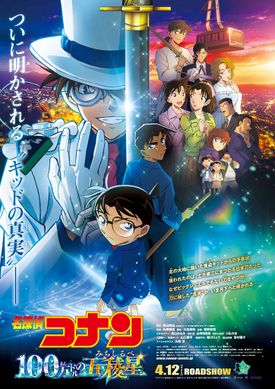
It’s been over 30 years since the affable and rambunctious Detective Conan splashed his way onto the pages of Weekly Shonen Sunday. In that time, there have been over 1000 manga chapters and nearly as many anime episodes. It’s a cultural phenomenon beloved by children and adults all over Japan. And why shouldn’t it be? It’s full of tight writing, entertaining characters, likable artwork, and, most importantly, a killer formula.
Yes, like Sherlock Holmes, Hercule Poirot, and who could forget the incomparable Scooby-Doo before him, the whodunnit/murder mystery has proven a bottomless pit of stories for writer Gosho Aoyama. (or at least variations of a few very similar stories) That’s not to disparage any of these series. I have a deep love for all of them and episodic mystery properties in general.
However, it’s noteworthy, that Sir Arthur Conan Doyle only wrote 60 Holmes cases, Agatha Christie only wrote 33 Poirot books, and the original run of Scooby-Doo only lasted for 41 episodes. Conan has solved more cases than those three combined AND doubled. Aoyama has added so much lore and characters; it’s become far broader in scope than the average mystery serial. I started reading Conan 3 years ago, and I’m only up to chapter 200 or, to put it another way, less than 1/5th the entire story. Understandably, I’m woefully unprepared for the 30th-anniversary film just released, Detective Conan: The Million-dollar Pentagram (2024). However, part of what made this series so addictive to me in the first place was the jump-in wherever nature of it. So I was hopeful I would not be too lost.
I was half right. This film mainly focuses on Conan and his two rivals Kaito Kid and Hattori Heiji, as they race to solve a mystery surrounding multiple different Katana, a mysterious star symbol, and a treasure worth a million dollars. The mystery itself is delightful. Full of twists, turns, funny character interactions, and the clever deductive reasoning you have come to expect from the franchise.
The problem comes in all the other sections. During the manga’s illustrious 30-year stint, the cast has ballooned to mammoth proportions. This is fine in serialization, where you can ignore certain characters for years. However, a film has a certain responsibility to be huge, larger than life, even. This, in turn, results in a larger-than-life cast. We have our main cast, Kaito Kid, Hattori and his supporting cast, all the other detectives, as well as the new cast created solely for this film.
In a whodunnit, the main focus should always be the mystery and the core dynamics between the main cast; Which is hard to build when so much of both are set to the side every 10 minutes. Poor Ran (the series’s core female lead) has barely anything to do the entire film. It’s also confusing. Two of the supporting characters look suspiciously like Ran and her father Mouri. I believe that is probably part of the joke of the characters, but since I have not seen them before, I was confused whenever they were on screen. I was confused seeing so many different characters the film expected me to know already.
Maybe the film was made for people who ARE caught up with the story and DO know all these characters. I’ll admit Conan is not the only series that has this issue. The recent One Piece films have also taken the liberty of smashing in as much of the supporting cast as they can fit whenever one comes out. Generally, I am neutral to positive on these “harmless” pieces of fanservice, as I am caught up with the show. However, they certainly don’t add much to the films, and like Conan, they do tend to suck the urgency out of the project. Nothing gets my blood pumping like an unrelated fight involving a minor character we haven’t seen in nearly 15 years. I would not blame anyone for feeling there was a sharp barrier to entry in these One Piece films, and it’s a hindrance in modern Conan films as well.
The switch to the big screen also demands an elevation of scale. Murder mysteries are generally more downplayed. Involving more investigation and conversation. However, this is a big blockbuster entry in one of the longest-running anime franchises of all time. The ending has to include a big bombastic action sequence, no matter if it clashes with the tone. There is one particular scene in the climax involving Heiji and an airplane, that was so confoundingly stupid that I laughed when it happened.
I think these moments put into perspective why the murder mystery formula works so well, but also why film is a particularly difficult medium to adapt it in. One of the defining features of film is grandeur, and the murder mystery gets by mostly on conformity. It’s a very comfort food type of genre and in a way, it works better when one focuses on quantity over quality. That way the baser pleasures can shine through, instead of needing to be something it’s not. That’s why Sherlock worked so well as a serialization or short fiction, instead of a TV Show that airs 3 episodes every 4 years; Poirot worked best when multiple books were being released a year, and not single films released every 5 years, or yes Why Detective Conan works best as an all-ages manga released once every week.